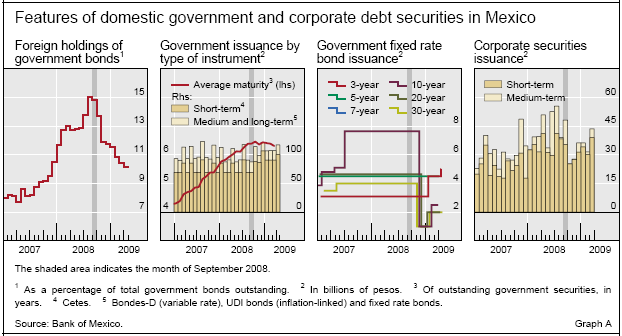Performance of domestic bond markets during the current crisis
(Extract from pages 58-59 of BIS Quarterly Review, June 2009)
It has been argued that domestic bond markets could provide a "spare tyre" to offset the withdrawal of external financing during periods of financial stress. However, the performance of these markets during the current crisis has been mixed. On the one hand, domestic government bond markets have provided a financing alternative and have exhibited as much resilience as international bond markets. On the other hand, foreign investors have tended to reduce their bond holdings and there has been a shift towards shorter-maturity instruments.1
Financing alternative for governments. Although domestic bond issuance in most of the region fell during autumn 2008, it later resumed at lower levels. Most governments have been able to roll over short-term debt, swap maturing for longer-maturity debt, or sell new debt.
Resilience of domestic government bond markets. While domestic bond returns became more volatile during the episode of stress that followed the Lehman episode, their volatility was lower
than that for international bonds, and is now at levels comparable to those before the episode. To be sure, recent policy efforts to supply liquidity and to stabilise domestic bond markets may have
played a role in the decline in volatility. Such performance suggests that, from the point of view of a Latin American resident whose revenues and expenditures are to a large extent in local currency
(eg a government), there are advantages to relying on domestic markets for financing.2
Lower foreign investor holdings. This is illustrated by the experience of Mexico, which has one of the most developed and open domestic bond markets in Latin America. The share of foreign holdings of government bonds declined abruptly after the Lehman bankruptcy. The market was disrupted, and there was a sharp increase in bond yields, particularly at longer maturities (Graph A, first panel). To satisfy the demand for short-term instruments and counter the rapidly falling demand for long-term bonds, the Mexican Treasury reduced long-term bond issuance during the fourth quarter of 2008 (both for fixed rate and inflation-indexed instruments) and increased the issuance of shorter-term instruments (Graph A, second and third panels).
Shift towards shorter maturity instruments. In Mexico, private domestic issuance (financial and non-financial) was disrupted. No medium-term bond issues were made during October and November (Graph A, fourth panel). The issuance of short-term securities also declined, but remained at levels comparable to those seen during 2007. Across the region there have been some exceptions in which highly rated corporates placed new debt at relatively long maturities. For instance, this is the case of private banks in Colombia (eg Bancolombia and Davivienda).
Overall, the performance of local currency bond markets as an alternative to international bond financing during this crisis has been mixed. This may reflect a less advanced stage of development and the severity of the global shock. An important issue for policy is that local currency funding for the government appears to have been more stable than funding for corporations.
1 Over the past decade bond markets in the region have deepened, becoming the main source of debt financing. In 2008, outstanding domestic debt securities reached an average of 37% of GDP, compared to 9.6% for international debt securities. For an overview of the development of these markets, see Tovar and Quispe-Agnoli (2008), Jeanneau and Tovar (2006, 2008), BIS (2007) and Scatigna and Tovar (2007).
2 The comparison may not be entirely fair because efforts to supply liquidity and to stabilise domestic bond markets may have helped reduce volatility in domestic bond markets.

